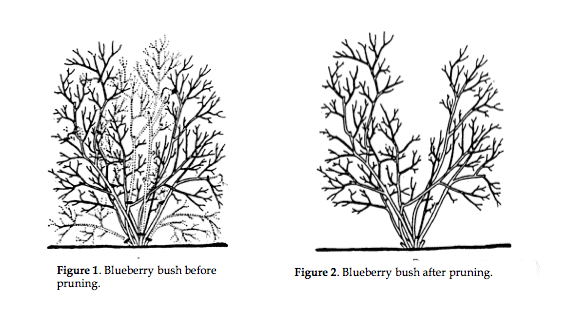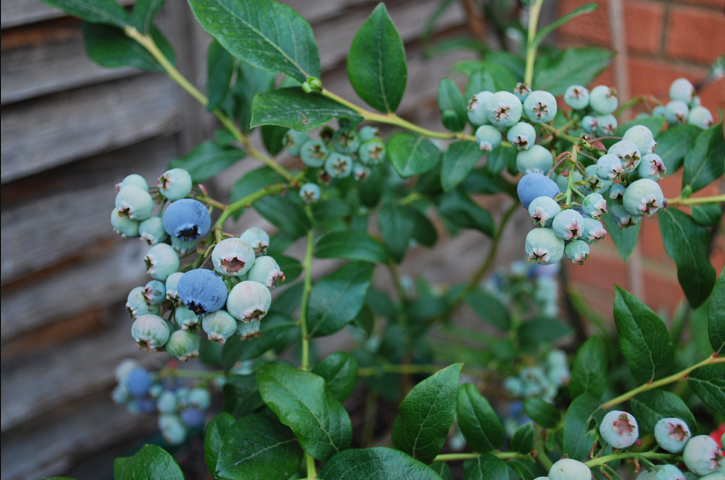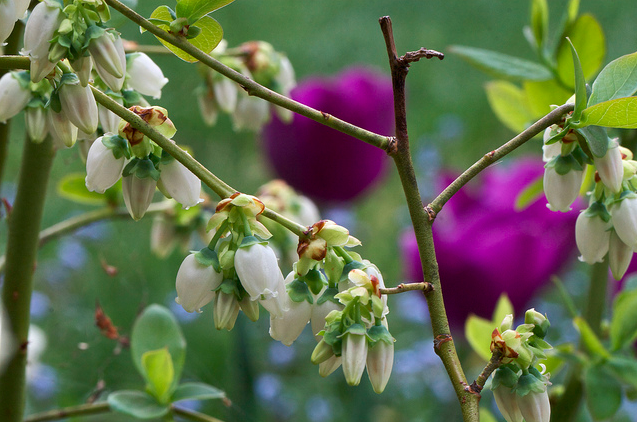In one of my night classes at the Brooklyn Botanic Garden, the summer sun setting, the hot day finally cooling into purple evening, we stopped to look at a beautiful sourwood tree, its innumerable strands of white flowers outlined in wispy arcs against the sky. That’s when our instructor, one of the garden’s arborists, said something I’ll always remember: if she had to limit herself to one plant family for the rest of her life, it would be the Ericacea Family — the heathers — a family that includes sourwoods, azaleas and…blueberries.
The tree was beautiful, but really? That’s the plant family she’d pick? I was doubtful, until this winter, when the winter blooming heather on my terrace cheered me every day of January and February. Until last fall when the leaves on my azalea bush turned the most vivid shade of scarlet and this spring when it broke out in confetti of pinkest pink. And until I saw a blueberry bush in bloom. Behold:
The blossoms blush pink, hang back with the palest green, or glow a perfect snowy white, or all three at once, on the very same plant. Whatever the color, for me the tiny bells conjure a whole world in miniature — every time I look at them I see the billowing skirts of tiny dancers. And now I get it: the Ericacea family! Yes! Winter, Spring, Summer, and Fall, the heather family puts on a show both subtle and shocking.
Then of course there’s the fact of their tastiest family member, blueberries. When those perfect flower bells are gone, gorgeous dusky blueberries take their place. Sweet and beautiful. How could you not want to grow this bush?
If I’ve convinced you, here are 6 things you need to know about growing a blueberry bush of your own.
- Blueberry bushes don’t absolutely need another blueberry bushes to cross-polinate, but they usually bear more and better fruit if they have a friend. So consider planting two.
- You should plant your blueberry bush in early spring (March or so) or fall (October/November). The cooler weather puts lets stress on the new plant and gives it time to establish and gain strength before summer. A 2-3 year-old plant will give you the most satisfaction (one-year olds are slow-going).
- Blueberry bushes can put on six to ten inches of growth a year, so plan accordingly when you’re choosing a container.
- Blueberries like acidic soil, full of organic matter. If you plop them down in a pot full of standard potting soil, they’ll fizzle. You can start with regular potting soil, but then you need to spice it up with compost, aged saw dust, or peat moss, and then you need to drop the pH. You can do this in several ways: add store bought sulfur and follow the directions carefully, or throw in a whole bunch of pine needles (a nice way to recycle your dead Christmas tree). You want the pH to wind up between 5 and 5.5. (Testing kits are like $10).
- Blueberry bushes can give you fruit for decades to come, so if you’re serious about the long term, remove the flowers the first year to keep the bush from fruiting. That way it will develop a stronger root system and bear more heavily in future years. (If you don’t have a years-long time horizon right now, it’s not a crime to leave the flowers and take what berries you can get).
- Blueberry bushes need to be pruned to thrive. Prune them each year in the winter, when they’re dormant (January or February). Remove any branches (canes is the proper term) that are diseased or broken or too close to the ground. Remove any branches/canes 6-8 years-old or older. Open up the center and narrow the bottom. Here’s a nice diagram (source):

There you have it, friends. Six steps to blueberry heaven.
Tags: blueberries

Thanks! I am trying to grow blueberries in containers on my patio (only way I can control the PH of the soil) and your post is timely and so helpful!!
Thanks so much!!
Hoorah! Glad to hear it!! Hope it goes well. xoxo